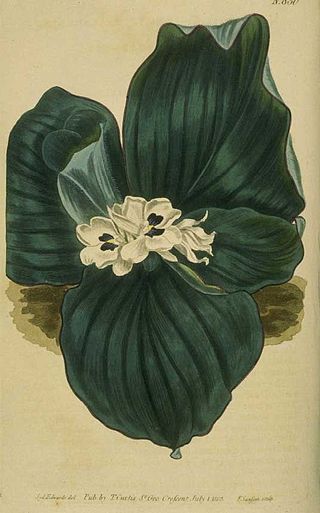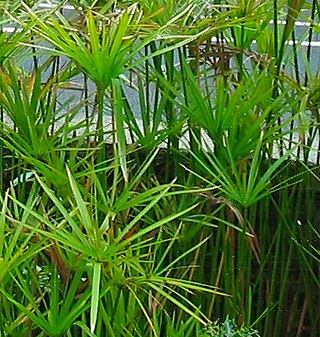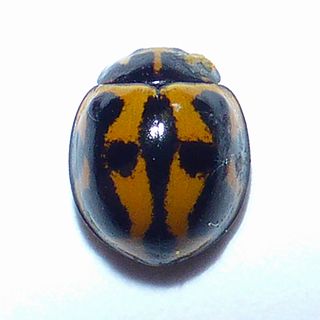
Galangal is a common name for several tropical rhizomatous spices.

Cyperus papyrus, better known by the common names papyrus, papyrus sedge, paper reed, Indian matting plant, or Nile grass, is a species of aquatic flowering plant belonging to the sedge family Cyperaceae. It is a tender herbaceous perennial, native to Africa, and forms tall stands of reed-like swamp vegetation in shallow water.

The Cyperaceae are a family of graminoid (grass-like), monocotyledonous flowering plants known as sedges. The family is large, with some 5,500 known species described in about 90 genera, the largest being the "true sedges" genus Carex with over 2,000 species.

Cyperus is a large genus of about 700 species of sedges, distributed throughout all continents in both tropical and temperate regions.

Cyperus rotundus is a species of sedge (Cyperaceae) native to Africa, southern and central Europe, and southern Asia. The word cyperus derives from the Greek κύπερος, kyperos, and rotundus is from Latin, meaning "round". The earliest attested form of the word cyperus is the Mycenaean Greek 𐀓𐀞𐀫, ku-pa-ro, written in Linear B syllabic script.

Cyperus alternifolius, the umbrella papyrus, umbrella sedge or umbrella palm, is a grass-like plant in the large genus Cyperus of the sedge family Cyperaceae. The plant is native to West Africa, Madagascar and the Arabian Peninsula, but widely distributed throughout the world. It has gained the Royal Horticultural Society's Award of Garden Merit. The subspecies Cyperus alternifolius ssp. flabelliformis is also known as Cyperus involucratusRottb..

Venturia inaequalis is an ascomycete fungus that causes the apple scab disease.

A bulbil is a small, young plant that is reproduced vegetatively from axillary buds on the parent plant's stem or in place of a flower on an inflorescence. These young plants are clones of the parent plant that produced them—they have identical genetic material. The formation of bulbils is a form of asexual reproduction, as they can eventually go on to form new stand-alone plants.

Cyperus eragrostis is a species of sedge known by several common names, including tall flatsedge, nutgrass, tall nutgrass, umbrella sedge, chufa, Earth almond, zula nuts, edible galingale and pale galingale.

Cyperus fuscus is a species of sedge known by the common name brown galingale, or brown flatsedge. This plant is native to much of Europe, Asia and North Africa from England, Portugal and Morocco east to China and Thailand. It is an introduced species in North America, where it is naturalized in widely scattered locations in the United States and Canada.

Cyperus scariosus is a perennial herbaceous plant from Australia and New Guinea.

Coelophora inaequalis, the variable ladybird, common Australian lady beetle or common Australian ladybug is a ladybird species endemic to Australia, Oceania and Southern Asia. The variable ladybird gets its name from the black markings on the adult elytra, that vary from one individual to another.
Trachelostenus is a genus of darkling beetles in the family Tenebrionidae. It is native to the Valdivian forests of Chile, and has at least two species, T. inaequalis (Solier) and T. fascicularis (Philipp). It was historically considered the only member of the family Trachelostenidae, but a 2015 study sunk the genus into the tenebrionid subfamily Tenebrioninae.

The elegant spreadwing is a species of damselfly in the family Lestidae, the spreadwings. It is native to eastern North America, including eastern Canada and the United States.
Copelatus inaequalis is a species of diving beetle. It is part of the genus Copelatus of the subfamily Copelatinae in the family Dytiscidae. It was described by Sharp in 1882.

Cyperus compressus, commonly known as annual sedge, is a sedge of the family Cyperaceae that has a wide distribution throughout countries with warmer climates. It is found in tropical areas of Africa, Asia and the Americas.
Pomatodelphis is an extinct genus of river dolphin from Middle Miocene marine deposits in Alabama, Florida, Brazil, Germany and France.
Curvularia inaequalis is a plant saprobe that resides in temperate and subtropical environments. It is commonly found in the soils of forage grasses and grains. The species has been observed in a broad distribution of countries including Turkey, France, Canada, The United States, Japan and India. This species is dematiaceous and a hyphomycete.













